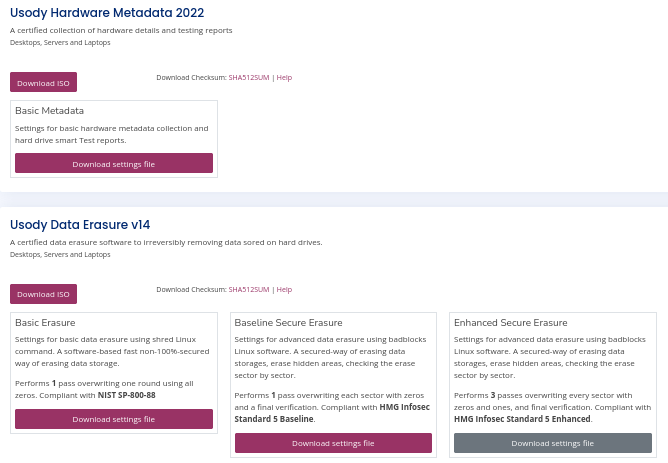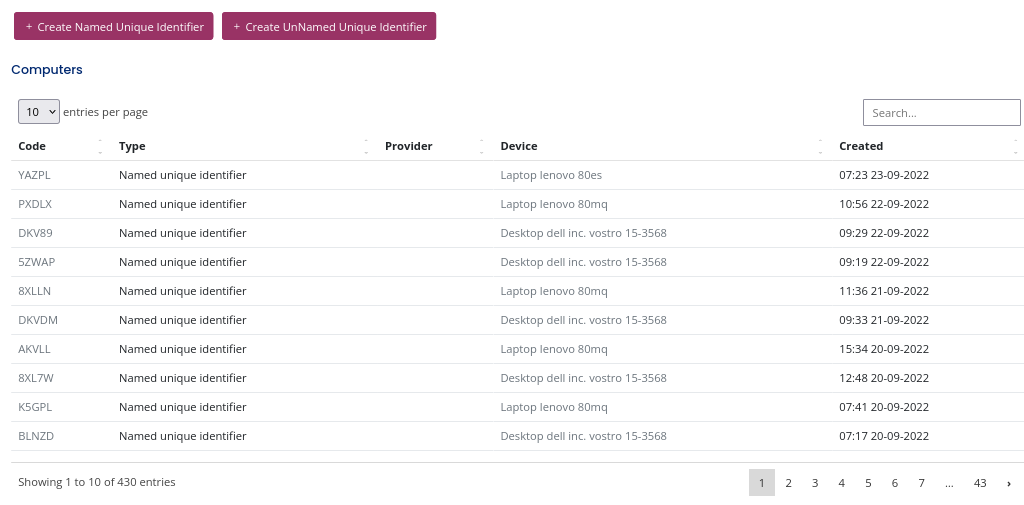Top Menu

Account
If you click on your account icon, the menu is displayed:

My Profile
In the profile option you can change your password.

Setup
The setup shows the links to the programs (ISO files) and the different configurations with which they can be executed (settings files).

Help
You will find a link to this manual.
Disconnect Session
Logs you out of your user session.
Reports
In reports, the general reports of the system are shown.

Lots report
The lots spreadsheet "Lots Spreadsheets" contains a list of all the lots in the system.

-
"Lot Id" unique identifier of the lot.
-
"Lot Name" name of the lot.
-
"Lot Type" type of the lot, it can have three values "Incoming", "Outgoing" or "Temporary.
-
"Transfer Status" status of the transfer, it can have the value "open" or "closed".
-
"Transfer Code" the transfer code.
-
"Transfer Date" transfer closing date entered by the user.
-
"Transfer Creation Date" date of creation of the transfer in the inventory.
-
"Transfer Update Date" update date of the transfer in the inventory.
-
"Transfer Description" description of the transfer.
-
"Devices Number" number of transferred devices.
-
"Devices Snapshots" number of transferred snapshot type devices.
-
"Devices Placeholders" number of transferred placeholder type devices.
-
"Delivery Note Number" number of the delivery note, declared by the supplier.
-
"Delivery Note Date" date of the delivery note, declared by the supplier.
-
"Delivery Note Units" number of units delivered, declared by the supplier.
-
"Delivery Note Weight" weight of the units on the delivery note, declared by the supplier.
-
"Receiver Note Number" number of the delivery note, declared by the receiver.
-
"Receiver Note Date" date of the delivery note, declared by the receiver.
-
"Receiver Note Units" number of units received, declared by the receiver.
-
"Receiver Note Weight" weight of the units of the delivery note, declared by the receiver.
Erased disk report
Shows a list of storage disks that have been erased with the Usody Erasure software.

Note: There are two ways to generate data erasure reports, device level or hard drive level, see the tutorial "Data erasures".
-
"Data Storage Serial" is the serial number of the storage disk.
-
"Snapshot id" is a snapshot file identifier generated by the "Usody Erasure Snapshots" software. To ensure it is globally unique whenever possible we use the UUID convention of RFC 4122.
-
"Type of Erasure" can have two values: "EraseBasic" or "EraseSectors". "EraseBasic" is fast but uses software that is not 100% secure as it does not detect bad sectors that have not been erased. The "EraseSectors" is slower but 100% safe because if there is a bad sector that cannot be erased, it will not generate the erasure certificate.
-
"PHID Erasure Host" indicates the "PHID" of the computer where the disk has been erased.
-
"Result" can have two values: "Success" or "Error". In case of "Success" it means that the disk has been successfully erased.
-
"Time" date of completion of erasing the disk.
See how to generate a disk erasure report
Identifiers
A unique identifier “Unique Identifier” allows you to link unique identification codes to devices. An identifier can only be associated with one device, but a device can have more than one identifier.

-
"Code" is a 5-digit identification code with numbers and decimals.
-
"Type" can take two values: "Named unique identifier" or "UnNamed unique identifier". "Named identifiers" are user-encoded identifiers and fulfill the property that they are unique in the context of the user's inventory, see how to create Named identifiers . The "UnNamed identifiers" are encoded by a provider (the code is generated automatically by an identifier server), and fulfill the property that they are unique in the context of the provider. See how create UnNamed Identifiers.
-
"Device" if there is a link between the device and the identifier, the title of the device is displayed.
-
"Created" date of creation of the identifier.